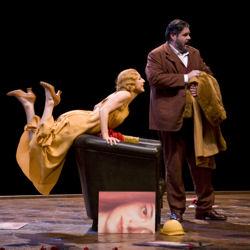“And then I woke up and it was all a dream!” was the last line of many a story scrawled in pencil in Mrs Phillibrown’s reception class at Great Totham Primary School on muggy Friday afternoons in 1980. Such was the success of this plot device that it spread around the world over the next few years until it was picked up by the producers of Dallas in 1986 and used to resurrect Bobby Ewing. Little did any of us know then that we were all paying homage to Erich Wolfgang Korngold, who used ‘the Phillibrown ending’ in his 1919 opera Die tote Stadt, now on for the first time at the Royal Opera House in London.
Korngold wrote Die tote Stadt (The Dead City) when he was only 23. The opera is based on a novel by Rodenbach and both tell the sinister story of a bereaved widower living in Bruges. Paul believes his dead wife, Marie, has returned to him in the form of feisty dancer Marietta, in Bruges with her troupe to perform at the theatre. Paul begins a passionate but dangerous affair with Marietta that threatens to cost him his reason as he wanders between grief and desire. Marietta is no angel and, in collusion with her fellow dancers, she tortures Paul to the point of madness, with disastrous consequences for them both.
It is incredible that such a young composer could conjure these complex and powerful emotions into such rich harmonies. Korngold’s score, expertly conducted by Ingo Metzmacher, is an intoxicating web of mournful longing and nostalgia: a dead city made of sound.
The high musical standard in this Vienna State Opera and Salzburg Festival co-production is matched by fantastic costumes and an excellent, versatile set. A room within a room on the stage and an actor doubling Paul offer a slanting, shifting perspective between past and present. The first appearance of the ghost of Marie in the second room is truly terrifying and the horror lingers as the boundaries between the rooms blur and crumble.
German soprano Nadja Michael takes on the dual role of Marietta and the ghost of Marie. Her movement is as good as her voice and this is no mean feat when so many of her lines are sung from a horizontal position: she does a good deal of seductive writhing and reclining. Michael is well supported by excellent ensemble work from cast members playing the other dancers.
Director Willy Decker injects enough ambiguity into the final scene to leave audiences uncertain whether Paul’s dream has done him good. Is he released from the City of Death or condemned to carry it inside him wherever he goes? Mrs Phillibrown would be proud.
Die tote Stadt is at The Royal Opera House Main Auditorium until 17 February 2009 Listing





